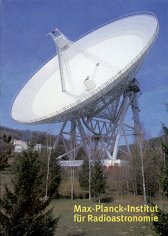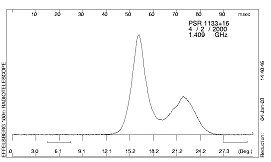Accept
Details & settings
This website uses cookies for cookie consent and statistics.
The project "Pulsar Research and Data Organization" consists of two parts:
|
This work began with an internship (July 2002) at the 100m radio telescope of the MPIfR in Effelsberg (Eifel). My main task was to find out as much as possible about pulsars from measurement data. A pulsar is a neutron star, which emits radio pulses. My main source of measurement data was the pulsar database of the MPIfR in Effelsberg, which is stored on more than 200 CDs. A key challenge was the absence of a practical table of contents. There was only a separate computer generated text file serving as table of contents for each CD, i.e. more than 200 text files. With a table of contents consisting of more than 200 files it was time consuming to answer questions such as "Has PSR 1133+16 ever been measured at 3.6cm?" or "Where can I find a good 9mm measurement of PSR 0329+54? Are there any?" Therefore, the creation of a practical table of contents was an obvious first step. Due to the large number of measurements (more than 21800) and the existence of digital "small tables of contents" it was easiest to create a database software that can read the computer generated contents files and which can search, sort and edit this information. The initial versions of this software must have been so convincing that I was hired for 1 month to program a more advanced version for the pulsar group of the MPIfR. The final result was a well-documented English version for Windows and Linux. It runs on a Windows/Linux (dual boot) computer in Effelsberg and the entire pulsar data archive of the MPIfR has been copied onto its hard drives (2x 160 GB). This allows my database software to pass the measurement data directly to the embedded pulsar data processing software and avoids the search for the right CD. Another system of this type will be set up for pulsar research at the MPIfR in Bonn. |

|

|
After completion of an initial version of the database software I focused on pulsar data (see figure) analysis. My goal was to learn as much as possible about pulsars on the sole basis of measurement data. These findings were intended to be independent from the results of other researchers. The resulting pulsar model, which is consistent with current research, can therefore answer many questions, while still being simple enough to be understood by members of the general public with a reasonable background in physics. Physics teachers can make lessons more interesting by asking their students in more advanced courses or an astronomy club to develop parts of the model themselves based on measurements (from this project or the internet). The model also offers many opportunities for further development, that I have not had a chance to explore (yet). The curious reader can also try to develop the model further (for pulsar data see http://www.mpifr-bonn.mpg.de/div/pulsar/data/). |
The pulsar model focuses on the following aspects:
|

|
All results are my own findings on the sole basis of measurement data, unless stated otherwise. Some questions, especially in relation to the emission process, are currently (2002/2003) still being investigated by the research community as there is still no model that can fully explain all observations.
It was a special honour that the pulsar group of the MPIfR invited me to give a talk, which I gave on September 17th 2002 at the MPIfR in Bonn. My presentation in English (50 minutes) covered both the pulsar measurement database and the pulsar model and resulted in a lively discussion during which the researchers confirmed that my findings are consistent with their research. I was particularly thrilled that Alex Wolszczan was in the audience. He is the pulsar researcher who discovered the first two extrasolar planets in 1991 (a planetary system around the pulsar B1257+12) using the Arecibo Telescope (Puerto Rico).